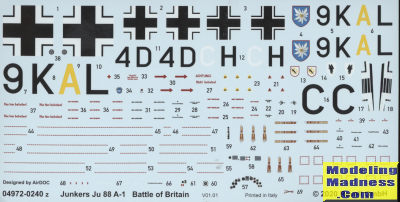
| KIT #: | 04972 |
| PRICE: | $ |
| DECALS: | Two options |
| REVIEWER: | Scott Van Aken |
| NOTES: | S |

| HISTORY |
The Junkers Ju 88 is a German World War II Luftwaffe twin-engined multirole combat aircraft. Junkers Aircraft and Motor Works (JFM) designed the plane in the mid-1930s as a so-called Schnellbomber ("fast bomber") that would be too fast for fighters of its era to intercept. It suffered from technical problems during its development and early operational periods but became one of the most versatile combat aircraft of the war. Like a number of other Luftwaffe bombers, it served as a bomber, dive bomber, night fighter, torpedo bomber, reconnaissance aircraft, heavy fighter and at the end of the war, as a flying bomb.
Despite a protracted development, it became one of the Luftwaffe's most important aircraft. The assembly line ran constantly from 1936 to 1945 and more than 15,000 Ju 88s were built in dozens of variants, more than any other twin-engine German aircraft of the period. Throughout production the basic structure of the aircraft remained unchanged.
The A-1 variant was the initial production aircraft and the first few aircraft were available for the initial invasion of Poland in September 1939. It wasn't until mid-1940 that there were sufficient aircraft in service to allow the type to make an impact on the war. The initial variant can be distinguished from the later versions by the shorter wings and the lack of a balance notch at the top of the rudder.
| THE KIT |
 This
is the second kit of the initial production version of the Ju-88 produced. AIMS
did an all resin version several years ago, but this is the first injected kit
in 1/72. Many of us were wondering if Revell were going to downsize their 1/32
kit and apparently they did, though it took a long time. The level of detailing
is everything we have come to expect from modern Revell kits and the interior
surpasses the previous best in this scale, which was Zvezda (Hasegawa's
interiors are generally fairly basic).
This
is the second kit of the initial production version of the Ju-88 produced. AIMS
did an all resin version several years ago, but this is the first injected kit
in 1/72. Many of us were wondering if Revell were going to downsize their 1/32
kit and apparently they did, though it took a long time. The level of detailing
is everything we have come to expect from modern Revell kits and the interior
surpasses the previous best in this scale, which was Zvezda (Hasegawa's
interiors are generally fairly basic).
The forward fuselage is a separate piece, which is fairly standard for those companies wanting to do other variants. There are the usual inserts for the upper front and rear cockpit section to deal with the different noses and rear gun positions. The bomb bay piece actually attaches to the cockpit underside and provides mounting for cameras. One builds up the tail gear assembly and traps it between the fuselage halves before attaching the lower fuselage section, which includes the roof of the bomb bay, though the bay cannot be modeled open.
One then moves on to the wings, which have separate wing tips for this version. One has to open holes for the bomb racks and dive brakes prior to gluing the halves together. Separate flaps and ailerons are supplied. The wheel wells are then built up, but you can attach the main gear after painting. At this time, the wings are attached to the fuselage. Then the fin and tailplanes are done and glued on.
The next several steps are on constructing the engine cowlings and the bomb racks. These are then glued in place, followed y the landing gear and doors. Note that if you want to build the kit in flight, that option is provided though there is no stand. The last items are the lower gondola as well as all the clear bits.
 Two markings
options are provided on the decals. Both are RLM 70/71/65. As the 70 and 71 are
so close to each other in shade, it is difficult to see them clearly in the
instructions. Might be worth scanning the painting guide and making it lighter
so the contrast is greater. The box art plane is with 3./KG 51 based at Orly in
June 1940 while the other is with 1./KG 30 in Germany during July 1940. Decals
are nicely printed and you'll have to get swastikas from another source.
Two markings
options are provided on the decals. Both are RLM 70/71/65. As the 70 and 71 are
so close to each other in shade, it is difficult to see them clearly in the
instructions. Might be worth scanning the painting guide and making it lighter
so the contrast is greater. The box art plane is with 3./KG 51 based at Orly in
June 1940 while the other is with 1./KG 30 in Germany during July 1940. Decals
are nicely printed and you'll have to get swastikas from another source.
| CONCLUSIONS |
I am glad that we now have a fairly easy to build early Ju-88A. It is not surprising that the kit is broken down just like every other Ju-88 in this scale since Hasegawa released theirs, which means care needs to be taken to build it. It is a level 4 out of 5 for just that reason. I look forward to building this one and adding it to my small, but growing 88 series of models.
| REFERENCES |
https://en.wikipedia.org/wiki/Junkers_Ju_88
October 2020
Copyright ModelingMadness.com. All rights reserved.
If you would like your product reviewed fairly and fairly quickly, please
contact
the editor or see other details in the
Note to
Contributors. Back to the Main Page
Back to the Review
Index Page
Back to the Previews Index Page